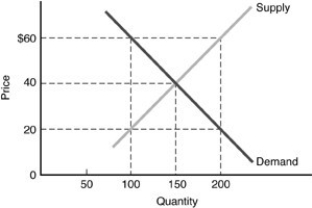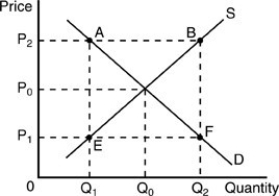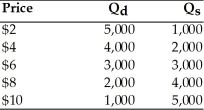A) promoting the attainment of an unhindered market equilibrium.
B) allowing quantity demanded to adjust to equality with aggregate supply.
C) creating excess quantities demanded or excess quantities supplied.
D) pushing prices to market clearing levels more rapidly than private market forces.
Correct Answer

verified
Correct Answer
verified
Multiple Choice
All of the following reduce the transaction costs for consumers EXCEPT
A) eBay.
B) a shopping mall.
C) a court decision regarding product safety.
D) a grocery store.
Correct Answer

verified
Correct Answer
verified
Multiple Choice
What is the result of an agricultural support price established above the equilibrium price?
A) The market gravitates toward and remains in equilibrium.
B) There will be excess quantity supplied of the product involved.
C) There will be excess quantity demanded the product in this market.
D) Since the support price is set above the equilibrium price, it will have no impact on the market price.
Correct Answer

verified
Correct Answer
verified
Multiple Choice
 -Refer to the above figure. If the government imposes a price ceiling of $60
-Refer to the above figure. If the government imposes a price ceiling of $60
A) the quantity traded will be 150, and the price will be $40.
B) the quantity traded will be 100, and the price will be $60.
C) the quantity traded will be 200, and the price will be $60.
D) the quantity traded will be 150, and the price will be $60.
Correct Answer

verified
Correct Answer
verified
Multiple Choice
When the supply and/or demand curve shift, the new market clearing price is
A) reached instantaneously.
B) reached only after the government intervenes in the market.
C) reached after some period of adjustment.
D) never reached.
Correct Answer

verified
Correct Answer
verified
Multiple Choice
We cannot predict the effect on the equilibrium quantity, but know that the market clearing price will increase when
A) supply decreases and at the same time demand increases.
B) supply increases and demand increases simultaneously.
C) supply and demand decreases simultaneously.
D) supply and demand increases simultaneously.
Correct Answer

verified
Correct Answer
verified
Multiple Choice
Which of the following statements is NOT true about exchanges in the market system?
A) In voluntary exchange both parties are better off because of the exchange.
B) Exchanges occur only in situations of barter where the market price is irrelevant.
C) Prices indicate what is relatively abundant and what is relatively scarce.
D) Transaction costs in exchanges include the cost of enforcing a contract as well as the costs of information.
Correct Answer

verified
Correct Answer
verified
Multiple Choice
A limit on the amount of strawberries that can be imported into the United States is an example of
A) the rationing function of prices protecting domestic strawberry farmers.
B) a price floor set by the government.
C) a price ceiling set by government.
D) an import quota.
Correct Answer

verified
Correct Answer
verified
Multiple Choice
An example of a black market is
A) a retail market.
B) a discount market.
C) scalping.
D) barter.
Correct Answer

verified
Correct Answer
verified
Multiple Choice
 -Refer to the above figure. Other things being equal, when the government imposes a price floor at P2, then we would expect
-Refer to the above figure. Other things being equal, when the government imposes a price floor at P2, then we would expect
A) the quantity demanded is Q2.
B) a surplus will occur.
C) price to decline until an equilibrium is achieved at P0.
D) consumers to bid against each other for goods and force the price even higher.
Correct Answer

verified
Correct Answer
verified
Multiple Choice
Suppose that consumer income increases and that ground meat is an inferior good. Which of the following will occur in the market for ground meat?
A) Market clearing price will rise, and equilibrium quantity will rise.
B) Market clearing price will fall, and equilibrium quantity will fall.
C) Market clearing price will rise, and equilibrium quantity will fall.
D) Market clearing price will fall, and equilibrium quantity will rise.
Correct Answer

verified
Correct Answer
verified
Multiple Choice
Market clearing prices in a market system act as
A) a signaling device.
B) a direct measure of resource costs.
C) a way for producers to advertise.
D) a legally determined rationing device.
Correct Answer

verified
Correct Answer
verified
Multiple Choice
A price floor set below the equilibrium price will cause which of the following?
A) an increase in demand
B) a shortage
C) a surplus
D) none of the above
Correct Answer

verified
Correct Answer
verified
Multiple Choice
The City Council of Happy Village is thinking about imposing rent controls. If they put rent controls in place, which constituency are they trying to please?
A) landlords
B) all taxpayers
C) existing tenants
D) all voters
Correct Answer

verified
Correct Answer
verified
Multiple Choice
People consume more fresh fruit in the summer than during the rest of the year, yet the prices of fresh fruit are lower in the summer than in other seasons. What accounts for this?
A) Fresh fruit is not subject to the law of supply.
B) The supply of fresh fruit increases in the summer.
C) Fresh fruit is an inferior good.
D) Fresh fruit is not subject to the law of demand.
Correct Answer

verified
Correct Answer
verified
Multiple Choice
Assume that the market clearing price for portable power banks is $5, but that the maximum price that can be charged is $4. This is an example of
A) a price control that will lead to a surplus of portable power banks on the market.
B) a price floor that will lead to a shortage of portable power banks on the market.
C) markets failing to ration a fixed quantity of portable power banks.
D) a price ceiling that will likely lead to a shortage of portable power banks on the market.
Correct Answer

verified
Correct Answer
verified
Multiple Choice
 -Consider the above table. Assuming the government imposes a price ceiling on strawberries of $4 per pound, what would be the likely result?
-Consider the above table. Assuming the government imposes a price ceiling on strawberries of $4 per pound, what would be the likely result?
A) a surplus of 2,000 pounds of strawberries
B) a shortage of 2,000 pounds of strawberries
C) No change, equilibrium would prevail.
D) The quantity demanded of strawberries would fall to zero.
Correct Answer

verified
Correct Answer
verified
Multiple Choice
 -A reduction in the minimum wage will tend to cause which of the following?
-A reduction in the minimum wage will tend to cause which of the following?
A) a reduction in poverty
B) an increase in the number of workers employed
C) an increase in the quantity supplied of labor
D) a reduction in the quantity demanded of labor
Correct Answer

verified
Correct Answer
verified
Multiple Choice
When the government sets a maximum price that can be charged for a good or service, it creates
A) a price support.
B) a price floor.
C) a white market.
D) a price ceiling.
Correct Answer

verified
Correct Answer
verified
Multiple Choice
In a market system, what must take place for quantity demanded to continually be equated with quantity supplied?
A) Price controls must be applied by governments.
B) Relative prices must be able to adjust to market clearing levels.
C) Tastes and preferences of consumers must adjust to eliminate surpluses or shortages.
D) Businesses must engage in involuntary, unprofitable exchanges to eliminate surpluses or shortages.
Correct Answer

verified
Correct Answer
verified
Showing 101 - 120 of 401
Related Exams